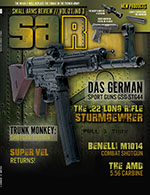The Polish Radom P64
By Oleg Volk
The Polish P64 is a simple blowback pistol that, at first glance, resembles both the Walther PPK and Makarov designs. Designed in the late 1950s and adopted in 1964, it was both the police and the military sidearm until the mid-1980s. While it looks like a PPK, it shares more technical features with PM (Makarov). Of relatively simple design and manufacture, it had advanced features like a drop safety. For a sidearm that was carried far more than it was fired, the safety improvement over the previously standard TT33 was important. The rest of the gun’s features may only be described as “a decent first try.”
From 1793 to 1920, Poland didn’t exist as a country. Prussia, later Germany, then the Austro-Hungarian Empire and Russia controlled its various parts. As a result, it had no real arms industry. During its brief independence, Poland produced minor modifications of American, German, Belgian and Russian arms, with Radom Vis 35 pistol being the only semi-original development. After WWII, Poland was squarely under the control of the USSR and used primarily Soviet arms. For some reason, expediency or national pride, Poland attempted to develop its own arms, with such oddballs as the PM63 machine pistol as the result. Unlike Czechoslovak designs, both conventional and unconventional Polish arms remain basic—the P64 is a vivid example of that.
The fit of parts and the quality of the finih are actually quite decent. The pistol, though heavy at 22oz empty, is very compact and streamlined, a good fit for concealed carry. Why that was considered important for an army pistol, I have no idea. It’s not surprising that the Polish army never fully adopted the P64, continuing the use of the TT33 alongside of it. Only a small portion of the 190,000 produced were used by army officers, with the rest of the production going to police or exported. Once replaced by better designs in the late 1970s and early 80s, many ended up exported to the US where they were sold off cheaply. The low price made them somewhat popular despite serious shortcomings.
I had two test samples, one a random pistol provided by the importer, the other hand-tuned model provided by a local friend. The first one proved problematic in several ways. Bullets exited without full stabilization, resulting in partial keyholing at 5 yards and a spread of a foot at 5 yard distance. It took both hands to move the safety/decocker lever. Decocking disabled the trigger mechanism, requiring full slide racking to get the pistol to shoot again. The second pistol was actually fully functional and was used as the basis for testing. The P64 is well-known for its heavy trigger, so I measured the pull. For the two guns, they were 28 and 25 pounds respectively in double action, 5 and 4.5 pounds in single action. Despite the heavy DA trigger, it turns out that accuracy was not limited by the pull. At five yards, both single action and double action (with de-cocking between shots) yielded 1.5 inch groups, the only difference being the speed of firing. The main limitation on accuracy turned out to be the loaded chamber indicator, a polished convex part placed just under the rear sight and causing nasty glare. How such a feature survived the initial testing is a mystery, especially since the top of the slide is textured specifically against glare!
The other problem with this pistol is the harsh recoil. The gun is unpleasant to shoot, requiring a low position for the support hand to avoid bruised knuckles. The canonical firing position of the time was one-handed, so it might not have been meant for a two-handed hold. Between the heavy DA trigger and the hard edges focusing the kick, 20 rounds fired through P64 caused my hands to shake badly for the next hour. For comparison, the 26oz PM pistol fired with the same Red Army Standard ammunition grouped 3/4” at the same distance DA or SA, and that’s with my shaking hands. Another difference between them is the magazine release. PM and P64 both use a heel release, but the Russian 8-shot magazine is easy to extract, while the Polish 6-shot is difficult to extract with bare hands and impossible with gloves—the control is small, stiff and recessed. That further suggests that the gun was meant to be carried a lot and used hardly at all. As a police pistol, P64 may be considered borderline adequate, as an army gun it’s a badge of authority at best. With most Combloc carry directives specifying empty chamber carry, the heavy double action may have been less of a concern than we would think. Both of the sample pistols were reliable. For a non-institutional user, breaking the sharp edges of the grip and making the loaded chamber indicator with non-reflective would do much to make this pistol more pleasant to shoot.
The one area in which P64 excels is maintenance. Dropping the trigger guard down and pulling the slide rearward and up completes field stripping in about five seconds. In the age of corrosive ammunition, that was an important feature. Detail stripped doesn’t take all that long either, with plastic grips coming off to expose much of the remaining internals.
At this time, the P64 is available at around $200. It’s a usable pistol that takes commonly available 9x18mm ammunition, but it’s not a masterpiece of gunsmithing. Either the PM or CZ82 would be easier and more fun to shoot, while a more modern locked breech design would be preferable for practical carry.
This article first appeared in Small Arms Review V21N3 (April 2017) |
| SUBSCRIBER COMMENT AREA |
Comments have not been generated for this article.






